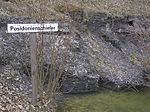detritus. In stream communities, few groups of animals became extinct. Stream communities rely less on food from living plants and more on detritus that...
95 KB (9,956 words) - 19:15, 11 January 2025
European mudminnows (Pisces, Teleostei, Umbridae)". Neues Jahrbuch für Geologie und Paläontologie - Abhandlungen. 263 (2): 93–109. doi:10.1127/0077-7749/2012/0214...
8 KB (890 words) - 22:48, 21 December 2024
lives in burrows in barren sandy coastal seafloor and feeds by filtering detritus from the water. It can be detected by a short row of three openings through...
13 KB (1,309 words) - 16:50, 24 July 2024
hand, to now, mudrocks have been important. The first book on mudrocks, Geologie des Argils by Millot, was not published until 1964; however, scientists...
24 KB (3,275 words) - 07:42, 17 January 2025
and remains of floating plants of highly variable size (mainly organic detritus, but also fragments of wood), fragments of bivalve shells and vertebrate...
61 KB (2,254 words) - 23:53, 10 January 2025
mammals and birds fed on insects, worms, and snails, which in turn fed on detritus (dead plant and animal matter). In stream communities and lake ecosystems...
196 KB (21,601 words) - 09:35, 16 January 2025
Theropod from the Upper Triassic of New Mexico, USA". Neues Jahrbuch für Geologie und Paläontologie - Abhandlungen. 205 (2): 189–208. doi:10.1127/njgpa/205/1997/189...
362 KB (17,483 words) - 17:26, 6 January 2025
Cloudina (Ediacaran): structural and ontogenetic evidences". Carnets de Géologie. CG2012_A03: 39–47. doi:10.4267/2042/46095. Ca/Mg ratios Domke, Kirk L...
28 KB (2,777 words) - 19:11, 13 January 2025
passive suspension feeders, filtering plankton and small particles of detritus from the sea water flowing past them with their feather-like arms. The...
42 KB (4,531 words) - 22:22, 30 December 2024
the east side of the Zakharoff Ridge; as well as a number of nunataks, a detritus zone and a moraine within it. The primary reason for designation of the...
82 KB (191 words) - 00:57, 7 December 2024
phytoplankton from the water. Protobranchs feed in a different way, scraping detritus from the seabed, and this may be the original mode of feeding used by all...
122 KB (13,233 words) - 10:13, 1 November 2024
algae, diatoms, flagellates, peridinians, small invertebrate larvae, and detritus. Unwanted material can be excluded by closing the epistome (lid above the...
54 KB (5,531 words) - 05:57, 22 August 2024
months, from June to October. Potamon ibericum is an omnivore, eating detritus, filamentous algae, and plant matter, as well as a variety of animals,...
10 KB (970 words) - 10:24, 16 December 2024
mainly fine silt, with varying amounts of quartz, feldspar, and carbonate detritus, and occasional pyrite. This formation suggests an open marine environment...
90 KB (5,026 words) - 18:57, 15 January 2025
several episodes of emersions, all of coastal origin and rich in plant detritus and leaf remains, connected to the typical Lithiotis reefs found in the...
45 KB (2,417 words) - 15:59, 16 January 2025
photosynthesis. These dark cave systems are often classified as allochthonous detritus because the dominant input of organic matter is from sources outside the...
38 KB (4,505 words) - 12:50, 29 October 2024
(1966). "Lias". Geologie von Mecklenburg-Vorpommern. 1 (1): 151–156. Tessin, R. (2010). "Lias: Mächtigkeit und Fazies". Atlas zur Geologie von Brandenburg...
89 KB (9,487 words) - 02:00, 29 December 2024
with sediment — and thus filling up — from the north west. As bioherm detritus and terrigenous infill accumulated, the coast prograded, and the reef zone...
19 KB (2,072 words) - 20:41, 28 July 2024
Liastongrube Grimmen. Sediment, Makrofauna und Stratigraphie". Ein Überblick Geologie. 16 (1): 550–569. Denckmann, A. (1887). Ueber die geognostischen Verhältnisse...
222 KB (5,779 words) - 04:30, 15 December 2024
volcanic ash, what indicated a clear contribution of volcanic-derived detritus during deposition. In the Austrian area, the volcanic materials where probably...
69 KB (7,718 words) - 03:06, 4 January 2025
"Lithiotis-Kalke" im Bereich der unterjurassischen Tethys". Neues Jahrbuch für Geologie und Paläontologie - Abhandlungen. 153 (3): 304–340. von Gloeckelsthurn...
131 KB (4,599 words) - 18:54, 15 January 2025
Maloof (2018). "Multiscale approach reveals that Cloudina aggregates are detritus and not in situ reef constructions". Proceedings of the National Academy...
458 KB (40,494 words) - 08:06, 6 January 2025
with carbonate-rich beds, deposited in a shallow marine setting. Coaly detritus, muscovite, very small shells and shell fragments, and framboidal pyrite...
86 KB (5,549 words) - 19:59, 3 January 2025
1080/11035894009452796. Retrieved 5 March 2022. Norin, R. (1934). "Zur geologie der Südschwedischen basalte" (PDF). Meddelanden Fran Lunds Geologisk-Mineralogiska...
131 KB (7,869 words) - 19:34, 3 January 2025


















